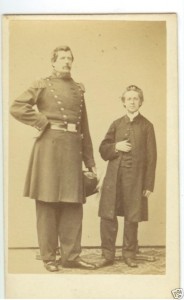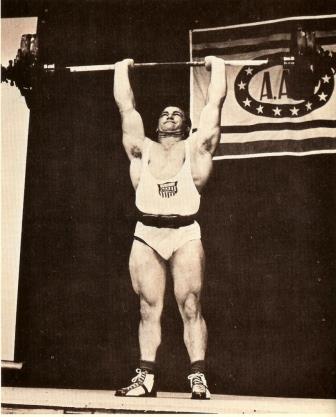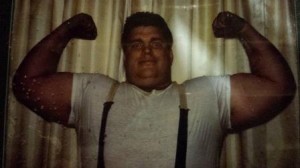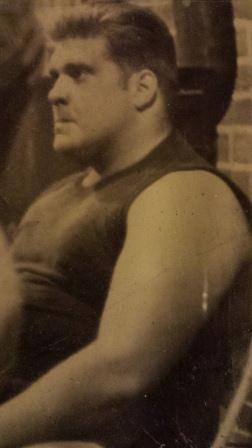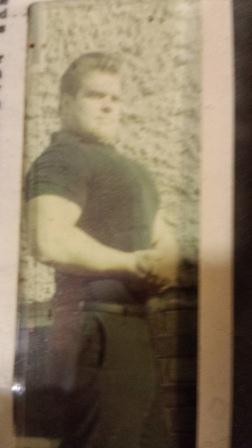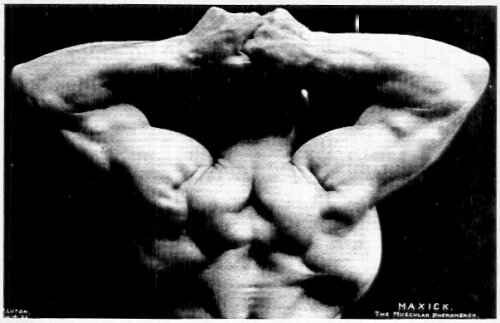Black Angus MacAskill
by Thom Van Vleck
I enjoyed hearing stories when I was a kid. You know…good, old fashioned story telling. Television was around, but with one channel the viewing was limited and since we live in a very rural area story telling in my family was a huge form of entertainment. My grandfather was the king of story telling….he had a great voice and a knack for painting a picture in your mind of not only words being said, but sights and even smells! He had been a fan of strongmen and wrestlers and I got to hear many stories about them. One in particular became a favorite. That is the story of Black Angus MacAskill.
Angus MasAskill was a giant but a special kind of giant. The Guinness Book of Records lists him as the largest “natural” giant of all time. He had normal proportions and no growth abnormalities. He may have been simply the biggest human being that has ever lived that achieved that size simply through nature and not the result of a disease process. At his peak he stood 7’9″ tall and weighed 500lbs. His palm was 8″ wide and his feet were 16″ long and 8″ wide. He also had a chest that measure 80″ around and shoulders that were 44″ across. Yet, if you saw him in a photo with no point of reference he looked like a “normal” sized man!
Something else made him special. He had great strength. He would often take on feats of strength but only if money were put on it. Some of the feats credited to him (as with all past feats, some questions may arise as to the authenticity so I leave it to the reader to judge for themselves) are as follows:
1. Shouldering a 2,800lb ships anchor (some speculate it was set up where he simply had to do what amounts to a partial lift).
2. Carry two 350lb barrels, one under each arm.
3. Hold a hunderdweight (112lbs) with two fingers at arms length for 10 minutes.
4. Life a full grown horse over a 4ft tall fence.
5. Set a 40ft tall mast single handed into a schooner.
6. Carried a sick man over his shoulder for 25 miles in a blizzard to a doctor without once setting him down.
7. Once was pulling a boat onto a beach and tore the boat in half.
Angus had many nicknames. He was “Black Angus”, “Mount Kaskill”, the Cape Breton Giant. He was from Cape Breton Island which was part of Nova Scotia but he was born on the Island of Berneray in the Outer Hebrides Islands of Scotland. It is a only about 4 square miles with barely over 100 people. It is about as barren and wind swept of an island as you could imagine. No wonder his father took him and his family to Nova Scotia! They settled near Englishtown in St. Ann’s Harbor which is also a very remote location. Later, many of the group that traveled with Angus’ family moved on to settle in New Zealand.
So Angus’ family had moved from a treeless windswept island to a land that had huge trees covering nearly every square inch so they quickly became lumberjacks. This was hard work and the MacAskill’s were all know for their strength, but not necessarily their great size. Angus was the exception in size. So we know he grew up doing back breaking, hard labor.
The story goes that Angus did not become exceptionally large until he was 12. He then grew quickly and gained the nickname Gille Mor which is Gaelic for “Big Boy”. While he was tremendously strong, he was at first clumsy. At 14 he traveled to Sydney, the largest town in the area, about 40 miles away by boat. He had never been to such a place and they all put in at a local tavern that had music and dancing. A local man was dancing and seemed to step on Angus’ large foot while he was sitting watching. Everyone laughed but Angus did nothing. This happened a second time and as good natured as Angus was, he still did nothing. But the third time proved the charm and Angus stood up and hit the fellow so hard he was at first thought dead! The ship’s captain found Angus hiding on the ship praying that the man was not dead.
There was a point where Angus’ father raised the rafters in his home to allow Angus to walk around upright. His father also built him a special, long bed. His father made his sons all work very hard and had a saying that Angus took to heart. “What’s worth doing at all is worth doing well”. While Angus grew up in a very strict Christian environment he also enjoyed making side bets on who could finish a hard job (which he often won) and getting together for a “Ceilidh” or party where bagpipes and fiddles were played and songs were sung with wine, rum, and whisky being shared!
Angus loved his home and most enjoyed fishing along in a rowboat in the bay were he could look at the wooded hills and farms. No doubt that is the reason that he returned there after traveling all over the world later with the circus. It is also interesting that the world may have never heard of Angus MacAskill because he loved his life and home and was reluctant to leave it. But a hard winter led to very hard times and he succumbed to and offer to travel as a giant. He was promised good money and it was a way to help his family.
There are many tales of him being on tour and doing feats of strength. One of my favorites was he entered a tavern and picked up a 140 gallon “puncheon” or barrel of scotch whiskey. He struck the top with his fist causing the bung or cork to fly out. He then picked up the barrel and drank from it while toasting the other patrons! Another was he was on a train when a robbery was attempted. When he stood up the robbers fled the train without any loot!
Angus often dressed in “Highland Costume” while on tour. He toured all over the world but often hated the heat of the warmer climates. There is a story that he once met Queen Victoria at Windsor Castle. Upon being presented with two gold rings by the Queen, he stomped his foot on the carpet to show his strength and left permanent marks with his boot heels. It was there that Angus supposedly held William Wallace’s sword in his hand at arms length being one of the few to accomplish this feat.
Angus made two world tours that often lasted years. His first return was a happy one with many of the same people still living in the area. But his final return found half the population gone. The timber market had slumped and growing crops or livestock was tough in that climate. But nonetheless, Angus retired to his home operating a store and mill with his friends and family close by. The story goes he was a good business man and disliked credit, but never turned away someone in need and was very generous to the local Church. He died at the age of 38 and was a friend and hero to all in his homeland. A legendary giant!
